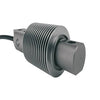
Tedea 355 Load Cell: Durable & Accurate Shear Beam Weighing Solution
, by Alif Vasaya, 5 min reading time

, by Alif Vasaya, 5 min reading time
The Tedea 355 load cell offers precision, stainless-steel durability, and IP68 protection. Ideal for platform scales, hoppers, and industrial weighing systems.
In modern industries where accuracy drives efficiency, load cells play a vital role. The Tedea 355 load cell stands out as a dependable single-ended shear beam sensor designed for precision weighing applications. Known for its durability and proven performance, it’s widely used in platform scales, conveyors, and process weighing systems. In this article, we’ll explore the design, features, and applications of the Tedea 355, while explaining why it’s a trusted choice across industries.
The Tedea 355 is a stainless-steel, single-ended shear beam load cell designed to provide accurate weight measurement under challenging industrial conditions. With an IP67/IP68 protection rating, it’s built to withstand harsh environments while delivering consistent results.
Capacity Range: 200 kg to 2000 kg
Material: Stainless steel for high corrosion resistance
Design: Hermetically sealed for durability
Mounting: Low-profile and easy to integrate
The compact form factor makes it an ideal choice for a wide range of weighing systems.
High accuracy and repeatability
Corrosion-resistant stainless steel body
Sealed to IP68 for moisture and dust protection
Compatible with multiple weighing assemblies
Global standard compliance (OIML approved)
These attributes make the Tedea 355 load cell highly reliable for industries that require stable, long-term performance.
The versatility of this model allows it to be used in a broad spectrum of weighing systems:
Platform Scales – For precise retail and industrial weighing.
Hopper & Tank Weighing – Ideal for material processing and batching.
Conveyor Weighing Systems – Ensures accuracy in logistics and production.
Industrial Automation – Integrates seamlessly into manufacturing lines.
By using the Tedea 355, businesses can reduce downtime, improve weighing consistency, and enhance overall operational efficiency.
Output: 2 mV/V
Accuracy Class: C3 (OIML certified)
Safe Overload: 150% of rated capacity
Operating Temperature: -20 °C to +70 °C
These specs make the Tedea 355 suitable for precision weighing in diverse environments.
The Tedea Huntleigh 355 load cell is engineered for industries where performance and reliability matter. With global approvals and robust stainless-steel construction, it’s trusted in food processing, logistics, manufacturing, and automation sectors.
For engineers and industrial buyers, this model strikes the perfect balance between cost, accuracy, and durability.
Q1: What is the main advantage of the Tedea 355 load cell?
It provides high accuracy with rugged stainless-steel construction, making it reliable in tough industrial settings.
Q2: Can the Tedea 355 be used outdoors?
Yes, thanks to its IP68 sealing, it performs well in outdoor and wet conditions.
Q3: What capacity ranges are available for the Tedea 355?
It is available from 200 kg to 2000 kg, covering most industrial weighing needs.
Q4: Is the Tedea 355 compatible with automation systems?
Yes, it integrates smoothly with conveyor and process automation systems.
The Tedea 355 load cell is a proven single-ended shear beam sensor that delivers precision, durability, and global compliance. Its wide application range, from platform scales to process automation, makes it a trusted solution for industries worldwide.
Explore more in our Load Cells category or connect with our team via the Contact Us page for expert advice.
For more technical standards on load cells, you can refer to the NIST guidelines.